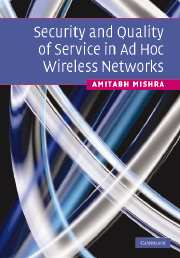1 - Introduction
Published online by Cambridge University Press: 26 February 2010
Summary
Wireless mobile ad hoc networks consist of mobile nodes interconnected by wireless multi-hop communication paths. Unlike conventional wireless networks, ad hoc networks have no fixed network infrastructure or administrative support. The topology of such networks changes dynamically as mobile nodes join or depart the network or radio links between nodes become unusable. In this chapter, I will introduce wireless ad hoc networks, and discuss their inherent vulnerable nature. Considering the inherent vulnerable nature of ad hoc networks, a set of security requirements is subsequently presented. The chapter also introduces the quality of service issues that are relevant for ad hoc networks.
Ad hoc networking
Conventional wireless networks require as prerequisites a fixed network infrastructure with centralized administration for their operation. In contrast, so-called (wireless) mobile ad hoc networks, consisting of a collection of wireless nodes, all of which may be mobile, dynamically create a wireless network amongst themselves without using any such infrastructure or administrative support [1, 2]. Ad hoc wireless networks are self-creating, self-organizing, and self-administering. They come into being solely by interactions among their constituent wireless mobile nodes, and it is only such interactions that are used to provide the necessary control and administration functions supporting such networks.
Mobile ad hoc networks offer unique benefits and versatility for certain environments and certain applications. Since no fixed infrastructure, including base stations, is prerequisite, they can be created and used “any time, anywhere.” Such networks could be intrinsically fault-resilient, for they do not operate under the limitations of a fixed topology.
- Type
- Chapter
- Information
- Publisher: Cambridge University PressPrint publication year: 2008

